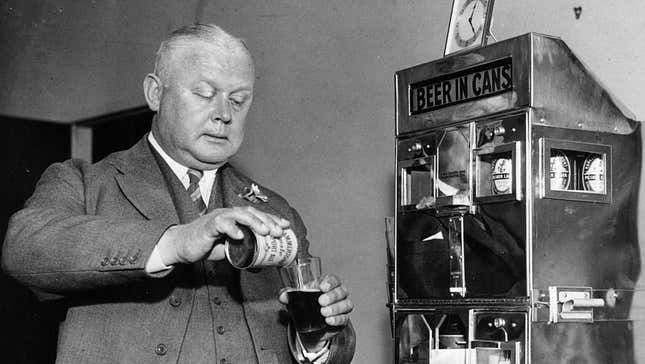
People love screaming about beer. Just look at the recent IPA discourse for proof. Big beers, small beers, barrel-aged beers, beers that taste vaguely like tires—there’s something out there for everyone, and brew fiends feel strongly about their ideal pint. We’ve touched on this before; for example, when we discussed the ideal amount of head on a beer. But with patio drinkin’ season just around the corner, I wanted to know: What’s the best way to pour beer from a can?
How to pour beer at the proper angle
A few years back, Takeout beer expert Kate Bernot recommended holding your beer glass at a 45-degree angle and “pouring the beer down the side of the glass until it’s about halfway full, then turning the glass straight up and down and pouring straight into its center.” I polled a number of beer nerds, and they mostly agreed with this suggestion.
“For a standard can, I angle it at about 45 degrees until I turn it straight up to form about an inch of head (or more depending on the style),” Riley, a Chicago bartender, told me via Twitter. “If it’s bigger than a 12-ounce can, there’s some left, but I just serve the can with the glass.”
The 45-degree approach results in a generally crowd-pleasing amount of head. But some beer drinkers demand more foam—much more.
What is the hard pour?
Nitro beers get to break the rules a little. Not to be confused with Nitro Pepsi, these smooth brews contain more nitrogen gas and less CO2 than other beers. This results in a thicker foam—but minimal carbonation in the beer itself. For that reason, nitro beers lend themselves to a hard pour. A hard pour is pretty much exactly what it sounds like: holding the can or bottle at a 90-degree angle and dumping the entire thing into your glass upside down. (Check out this video for a great showing of the hard pour technique, courtesy of Left Hand Brewing.)
Since nitro beers have significantly less carbon dioxide, the foam readily disappears, leaving behind a smooth brew with minimal head. But some people—like Arseny, an occasional homebrewer and passionate bar patron—utilize the hard pour for other styles of beer to avoid gassy bubbles. “Tipping at an angle so all the carbonation stays in, that’s a sucker’s game,” Arseny says. “I’m not drinking a La Croix.”
Arseny went so far as to send me an exquisite video of himself dumping what appears to be a can of High Life into a pitcher. In the video, Arseny empties the can at a full 90-degree angle, shakes it a bit, then pours the decanted (?) beer from the pitcher into a glass. As you might expect, the glass is almost all head at first—but, per Arseny, the head dissipates quickly, leaving behind a flatter beer. That’s a plus for Arseny, who explains that he’d rather taste beer than bubbles. Still, he adds: “People hate when I do this.”
It’s easy to see how some beer fans might take issue with the depleted carbonation. But as explained in this L.A. Times article, others might prefer the hard pour approach to reduce bloating.
“When the beer doesn’t foam in the glass, it’s probably foaming in your stomach and causing a nasty case of (you guessed it) bloating,” writes Holly Van Hare in the Times. She goes on:
When you don’t let any foam loose during your pour, the CO2 stays dissolved in the beer itself. Then, once you drink the beer and proceed to eat something - say, a nacho or a chicken wing - the foam explodes into a barrage of bubbles in your stomach. That’s what causes bloat.
Head Brewer Doug Hasker, head brewer at Puesto Cervecería, disagrees with the method. “Beer head is important to allow for the release of smell sensory as the bubbles dissipate,” Hasker says. “In humans, about 78% of taste is through the nose.” Hasker also notes that a hard pour typically creates a flatter, less carbonated beer than the brewer intended.
Ultimately, the best beer pour is the pour that you enjoy the most. If you’re not sure what’s best, the 45-degree standard is solid. Still, it all comes down to experimentation; just keep in mind that employing an unorthodox pour—the hard pour, for example—will change your drinking experience, potentially straying from the brewer’s intentions.